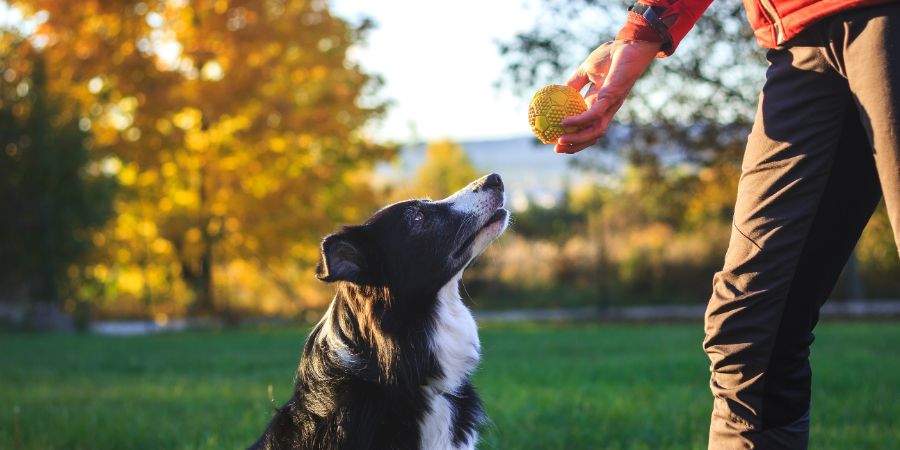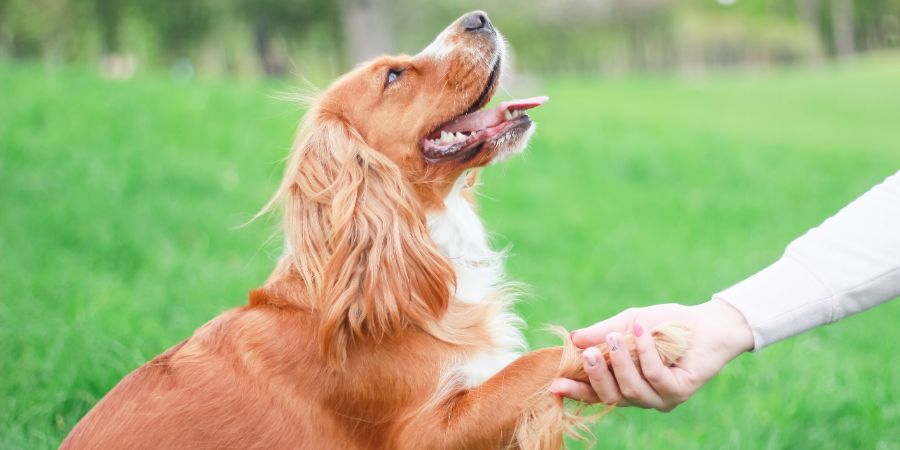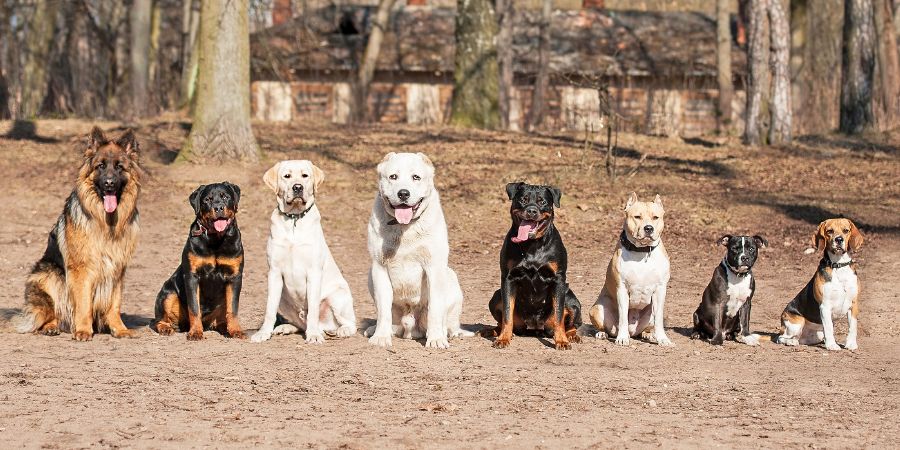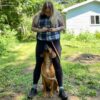I think we can all agree that dogs make the best of friends. After all, they’re loyal and they love to please their owners. However, training a dog can be difficult – especially if you don’t know what you’re doing. This is why, in this article, we’ll be discussing the six fundamentals for safe dog training.
In turn, these principles will help aspiring and professional dog trainers alike. The goal? To create a safe environment for you, your clients, and their canine companions!
So, without further ado, let’s get started!
What are the 6 Fundamentals of Safe Dog Training?
In order to safely train ANY of your client’s dogs, you – as the professional dog trainer – must ensure to check off the following 6 steps:
- Gathering the necessary information
- Preparing your client
- Providing a safe environment for the training to take place
- Meeting the dog
- Being prepared for any emergencies that may arise
- Understanding liability risks

Fundamental #1: Gathering Information
Before embarking on any training session, you must first do your due diligence and gather the necessary information.
The Client Consultation
Usually, this will start with the initial client consultation. During this in-person meeting or virtual communication, you and the client are speaking for the first time. This means that you should be using this opportunity to ask as many questions as possible, so that you can gain a better understanding of the specific situation.
For instance, you should ask them:
- How old their dog is;
- What breed their dog is;
- What their goals are in regards to training their dog;
- Whether or not their dog has any behavioral issues or health problems, etc.
Client Questionnaire
Alternately, you may want to provide each prospective client with a questionnaire prior to meeting with you officially. This way, you can have the filled-out questionnaire prior to the consult, and can therefore have a better understanding of them, their dog, and their needs ahead of time.
Should you choose to go this route, your questionnaire should allow clients to provide information on their dog’s:
- Age
- Sex
- Breed
- Temperament
- Medical history (e.g. are they spayed or neutered? Do they have any existing, relevant medical conditions that you should be aware of? Are all of the dog’s vaccinations up-to-date?)
- Any previous experience they have with dog training
- The client’s living situation
- The client’s availability and preferred schedule for training sessions (within your hours of operation, of course)
- Goals the client would like their dog to meet during dog training sessions
- Any behavioral issues they wish to have addressed
Not yet a trained, certified dog trainer – but want to be? QC Pet Studies’ self-paced, online Dog Training Course can help you start your career in as little as 12 short weeks!
Vaccinations
We can’t stress this enough: don’t forget to check and make sure that the dog’s vaccinations are up-to-date before beginning any training session. After all, there are certain vaccinations that are required by law for your client’s dog to have. A rabies vaccination would be a perfect example.
Of course, there are other vaccinations that aren’t mandatory. So, if you’re running your own dog training business, you get to use your own discretion to determine the types of vaccinations you require your clients’ dogs to have before beginning any training.
But once you’ve made that decision, make sure to stand firm on it. This is essential in order to protect both parties from illnesses and diseases, as well as other potential legal issues!
Core Vaccinations
That said, veterinarians swear by what’s known as “core vaccinations”. These include:
- DHP/DHPP: This is the Distemper and Parvovirus combination vaccine. Both of these infections are highly contagious.
- Rabies: As we mentioned previously, this one is required by law in many areas. It’s important to remember that rabies isn’t only a threat to the pet in question. Rather, it can also be a danger to you and other humans. So, if your clients’ dogs don’t have an up-to-date rabies vaccination, make sure to inform them of the risks.
Non-Core Vaccinations
On the other hand, there’s also what’s known as “non-core vaccinations”. These vaccines aren’t typically required, but they can help protect your client’s dog from other illnesses and diseases. Non-core vaccinations include:
- Bordatella: This specific type of infection (sometimes referred to as “Kennel Cough”) can spread quickly and easily, especially in less sanitary environments with multiple animals present.
- Leptospirosis: This is a bacterial infection that can cause serious kidney and liver damage, as well as other health problems. It’s spread through contact with animal urine or water.
- Lyme disease: This is a tick-borne infection that can cause long-term health issues in dogs and humans alike.
- Canine influenza: Also known as “dog flu”, this is a contagious respiratory infection that can be spread quickly and easily between dogs.
Again, as the dog trainer, you get to choose which of these non-core vaccinations you require for the dogs you train. But regardless of what you decide, make sure to communicate this clearly and consistently with your clients PRIOR to the first session.
Fundamental #2: Preparing Your Client
The next fundamental of safe dog training is to properly prepare your client so they know what to expect, what to do, and what not to do at your facility.
Training Methods
First, it’s important to educate your client on your training methods. For example, do you focus more on positive reinforcement? How long will each session last? What kind of commands does the dog need to know in order for the training to be successful?
This is all information the client needs to know!

Rules and Guidelines
Secondly, it’s also important to go over any rules and guidelines with your clients. For example:
- Do you have a designated area for the dogs to relieve themselves?
- Are there any specific rules about how the dog should behave while in your facility?
- Do you have any rules for how owners should be greeting and interacting with dogs during sessions?
- Would you prefer that clients refrain from interacting with other dogs other than their own?
- Is there a minimum amount of distance that clients should keep between one another during sessions?
- Should clients come prepared with poop bags and sanitary wipes, in case their dog has an accident during their session?
- Is there a certain dress code for clients while on the premises (such as proper footwear, etc.)?
Furthermore, make sure your client is aware that they must have their dog on leash at all times – unless instructed otherwise by you or another trainer on staff. Generally speaking, off-leash training will typically only be done during private lessons. If it’s a group lessons with other dogs, though, the leash must remain on at all times.
Your Cancellation Policy
Finally, it’s also important to go over your cancellation policy with the client prior to the first session. This should include letting the client know how much notice they need to give if they need to reschedule or cancel their appointment.
Once all this is established and understood, your client should feel more confident and ready to start their session with their four-legged friend. And they’ll also be well aware of how to properly follow your rules and guidelines while on the premises!
What are the steps to becoming a working dog trainer? These 5 steps break down the process from start to finish!
Fundamental #3: Providing a Safe Dog Training Environment
The third fundamental of safe dog training is to provide a safe environment for everyone involved. For starters, make sure you have taken the necessary safety precautions when designing – and maintaining – your facility. This includes making sure there are no:
- Electric wires or outlets that can be accessed by dogs;
- Sharp corners;
- Plastic small enough to swallow;
- Human foods and/or medications lying around;
- Cleaning fluids and insecticides that aren’t safely locked up and/or out of reach;
- Houseplants at dog level that are poisonous to them (e.g. Azalea, Oleander, Tulips, Lilies, etc.)
- And anything else that could potentially harm them.
Proper Hydration
Your clients’ dogs are going to be doing a lot of work during their sessions. As such, it’s important to make sure they are properly hydrated. Offer plenty of fresh, clean water for them at all times. Additionally, encourage your clients to bring extra water to their sessions if their dog is likely to need it.
It’s also a good idea to have a few (non-plastic) toys available so the dogs can play in-between their sessions and take a break from the heat and exertion.
If your training sessions are taking place outside, it’s extremely important to be mindful of the weather, too. Avoid training in extreme temperatures. If it’s too hot, the dogs can easily become overheated. So, offer plenty of breaks and utilize shady areas whenever possible.
Session Considerations
If you’re planning on offering group lessons, it’s also important to make sure that the dogs attending these sessions have been properly socialized. For example, if you can’t ensure that all of the dogs get along in a group setting, then it would be best to hold private lessons instead.
Next, it’s also important to provide breaks during your session for both you and the dog. Dogs can become overwhelmed with too much stimulation, so be sure to watch for signs that they need a break and provide it as soon as possible.
You’ll also want to make sure that you’re properly directing traffic flow during sessions. This means, coordinating things in such a way that dogs aren’t crossing paths unless it’s intentional. For example, if there are two groups of dogs working in the same environment (e.g., a small training space), make sure that they’re separated either by distance or using gates or other barriers.
Facility Considerations
There are certain things you should also make sure your dog training facility itself has in place. For starters, there should be certain outdoor training areas if you intend to provide on-site lessons. This includes areas for you to practice certain commands (e.g., recall and stay) as well as different surfaces for the dogs to explore and become familiar with.
Make sure these areas are fenced and clearly marked so that your clients can easily keep their dogs in sight at all times. Additionally, ensure the fencing is sturdy and tall enough so that other animals or people can’t easily access the area.
In addition to this, you should also create “calm zones” within your facility. These areas should be free from any distractions, including high-traffic areas or loud noises.
Finally, make sure your facility also has proper ventilation and air conditioning. This way, the dogs don’t overheat during their training sessions – especially if you plan on offering group classes.
Fundamental #4: Meeting the Dog
This might sound like common sense, but whenever you meet ANY dog for the first time, you should always introduce yourself properly. If you’re not 100% confident about how to do this, here are some tried-and-true tips:
Tip #1: Ask permission from your client.
Don’t simply walk right up to the dog without asking their owner if it’s okay first! Getting your client’s consent is key (and makes for the best first impression to them, too).
Tip #2: Let the dog be the one to approach you.
Not the other way around. Turn your body to the side slightly and don’t look directly at them. This will let the dog know that you’re not a threat, and they can come to you on their own terms. The dog may sniff the air for a while before approaching. This means they’re investigating the situation, so give them the time to do that. No need to rush them!
Tip #3: Give the dog some space.
Allow the dog to explore and sniff around, but don’t linger too close. Let them be in control of the situation and move away when they seem uncomfortable.
Tip #4: When you do touch, make sure to do it properly.
This means calm, slow, and steady movements. Do NOT immediately try to reach over and/or touch the top of their head. The dog might interpret this as a threatening gesture. It’s better to offer your hand palm-side up and wait for the dog to sniff it first before attempting any further contact. From there, gently scratch under their chin and only progress from there if the dog seems comfortable with what you’re doing.
Tip #5: Monitor the dog’s body language.
You should always watch the dog’s body language to ensure they’re not feeling anxious or uncomfortable. If you notice any signs of aggression, back off and give them space immediately.
Tip #6: Be mindful of your client.
If it’s their first dog training session, your client may be nervous or anxious. In turn, this can make their dog nervous or anxious, too. So, if you notice that your client is feeling overwhelmed, you should take the time to reassure them that everything is going according to plan and their pet is doing great!
Assess the Dog’s Health and/or Behavior
This part is especially important if your client has informed you ahead of time that their dog has some sort of medical condition and/or behavioral issue. Before you can even begin the training process, assess the dog’s current physical and/or mental state.
For example, if you notice that the dog is limping, take this as a sign that they may need medical attention before any further training is done. If you notice signs of aggression, such as growling or snarling, it’s best to start with basic obedience commands and work your way up from there.
Fundamental #5: Being Prepared for Emergencies
When it comes to dog training, anything can happen and accidents do occur – no matter how prepared you thought you were. To be a responsible professional dog trainer, you must always be aware of any potential hazards and risks when working with dogs.
The most common emergencies that may arise include:
- Heat stroke
- Choking or poisoning
- Trauma from an injury
In the event that one of these occurs, you must be ready to handle it quickly and effectively. Always have a first-aid kit on hand with all the necessary items such as bandages and antiseptic solutions. You should also keep your phone nearby in case you need to call for help or consult with an animal expert.

Dealing with an Aggressive Dog
As a trained professional, you should be able to observe canine behavior and recognize signs of aggression – before things escalate too far. For instance, a dog may exhibit any of these common signs of aggression towards you, other dog owners, or other dogs:
- Growling
- Baring teeth
- Lunging
- Mounting (this one would primarily be seen with other dogs)
- Standing over other dogs
Importantly, the rules you put in place during sessions should not allow dogs the opportunity to become aggressive with one another in the first place. This is why these rules – such as being on-leash at all times – are so critical!
That said, if a dog becomes aggressive during the training session, the key is to remain calm and step back. NEVER put yourself in an unsafe position, and don’t attempt to confront the dog directly. If you do this, you may very likely get bitten.
What to Do if a Dog Shows Aggression
Instead, remain calm, do not yell, and lead by example. Create space by instructing all of the dog owners to step away (and take their dogs with them, of course) from the aggressive dog.
Next, make noise by blowing into a dog whistle, clapping your hands together once (sharply), or using an air horn. In turn, this will likely distract the dog long enough to calm the situation.
What to Do if Dogs are Fighting
If two or more dogs happen to be fighting, there are a couple ways you can put a stop to it. After following the steps we just mentioned, you can do either of the following:
- Throw a blanket over the fighting dogs, as this will typically cause them to stop fighting in order to get out from under the blanket.
- Employ the “Wheelbarrow method“, in which you and another trained individual physically separate the dogs.
Once the fighting dogs have been separated, you’ll need to make sure that all of the dogs are okay. Check for any cuts or bruises, and then make sure the owners keep their dogs leashed until it’s time to go home.
The Importance of First Aid Knowledge for Safe Dog Training
As part of your qualifications as a professional dog trainer, it’s imperative that you have some sort of first aid training for canines. This will ensure that you know how to properly care for a dog in the case of any emergency.
First aid courses are offered online and through canine associations. They can provide invaluable knowledge on how to handle various medical emergencies such as:
- Minor cuts or scrapes;
- Allergic reactions;
- Choking;
- Seizures;
- Broken bones;
- Dehydration;
- Shock;
- Performing CPR on a dog, etc.
Furthermore, first aid training will help you know exactly what should be stocked within your first aid kit. For instance, your kit should include:
- Gauze
- Vet wrap
- Medical tape
- Telfa pads
- Sterile eyewash
- Non-stinging antiseptic wash
- Rubbing alcohol
- Rectal thermometer
- Hydrogen peroxide
- Tweezers
- Latex gloves
- Cold and heat packs
- Styptic powder, etc.
Did you know that QC Pet Studies’ online Dog Training Course offers an entire section devoted to first aid? It’s true – and it’ll allow you to start your professional career with confidence, knowing that you’re prepared to handle any emergency situation!
First Aid for Humans
Here’s the thing: your job will often require you to work with not only dogs, but their owners as well. Thus, it’s worth your time to get trained in first aid for people, too. Plus, this will only make your resume that much more impressive!
On that note, it’s also worth making sure that your facility has some first aid emergency items for people as well, and not just dogs. This should include:
- Bandages;
- Gauze pads;
- Antiseptic wipes;
- Tweezers;
- Scissors;
- Disposable gloves;
- Pain relievers, etc.
Fundamental #6: Understanding Liability Risks
Finally, the last fundamental of safe dog training is understanding liability risks. This is especially important if you’re running your own business. After all, as a professional dog trainer, you’re responsible for the safety of everyone in your facility at all times – and that includes yourself!
In the field of dog training, potential liability risks can include:
- A violation of public safety laws – for example, having an aggressive or out-of-control dog on the premises;
- Negligent behavior – not taking appropriate safety measures to protect owners, their dogs, and yourself;
- Inadequate insurance coverage – for example, not having necessary personal liability coverage;
- Unsafe training techniques – not following humane guidelines (e.g. using negative reinforcement training methods on the dogs);
- Client accusations – for example, a client accusing you of not properly handling their dog and that mishandling resulting in an injury.
To protect yourself from potential liability risks, it’s important to make sure that you have a Dog Training Agreement that all clients can read over, sign, and return to you BEFORE any sessions take place.
What to Include in Your Dog Training Agreement
Your Dog Training Agreement should include:
- A clear explanation of the type of training program you offer;
- The safety measures that will be taken to ensure the safety of the client, their dog, and yourself;
- An outline of the goals you and your client intend to meet through the training sessions;
- The length of the training;
- Dates of training;
- Your services rate(s);
- Your insurance policy number (if applicable);
- Any additional conditions or disclaimers.
If You Run a Limited Liability Company…
It’s worth noting that if your dog training business is registered as an LLC (limited liability company), you may not be protected from certain liability risks. For example, if you are sued for professional negligence and your LLC is found to be liable, the court may require that you personally pay any damages from your own assets.
Therefore, it’s important to make sure that you have the necessary insurance coverage and legal documents in place to protect yourself and your business. To ensure that you’re properly protected from any potential legal issues, it’s worth speaking to an attorney and/or insurance professional about your options for additional coverage.

How to Train Dogs Safely: Final Thoughts
At the end of the day, safe dog training is all about being prepared – both in terms of your knowledge and skills as a professional dog trainer, and also in terms of having the necessary safety measures in place.
From first aid to liability protection, it’s worth taking the time to ensure that you understand and follow all 6 fundamentals for safe dog training. Doing so will not only give you peace of mind but also help you be a trustworthy, knowledgeable professional that people can rely on and trust with their beloved animals.
Good luck, trainers!




